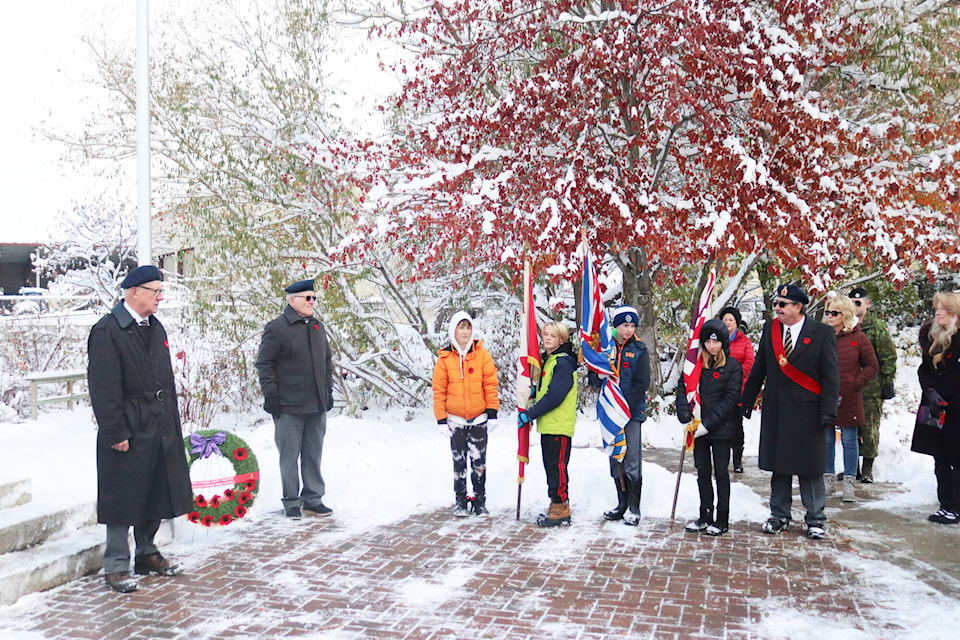Early winter weather may have caused some last minute scrambling, but it didn’t deter Coldstream students from honouring those who have defended Canada’s freedom throughout history.
Close to 70 students in grades six and seven from Coldstream and Kidston elementary schools took part in the district’s second annual No Stone Left Alone ceremony Tuesday, Nov. 8. The ceremony was moved from the Coldstream Cemetery to the local cenotaph due to recent snowfall.
Also in attendance were members of the B.C. Dragoons, Vernon branch of the Royal Canadian Legion, Vernon and District Family History Society and Vernon Lions Club.
Emcee and organizer Lawrna Myers read a statement from No Stone Left Alone founder Maureen Bianchini Purvis to start the ceremony.
“Participants, be proud of your service today. There is no higher legacy you can leave,” she said on behalf of Purvis.
“By being here today, let us shine a beacon of hope for our future that we continue to strive for peace and stability and be ever grateful for our safety and security.”
Students Alex Banman-Clark, Luke Buchanan, Andie Keens and Maren Jones served as the ceremony’s flag bearers. Coldstream student Macy Kelder read out Lt.-Col. John McCrae’s famous First World War poem, In Flanders Fields, while another Coldstream student, Cody Kiel, recited the Commitment to Remember. Kidston’s Quinn England and Porter Zadworny laid a wreath at the foot of the cenotaph.
In lieu of a trumpeter, a recording of the Last Post and Rouse was played.
Retired Major Ken Usher recited a verse from the Act of Remembrance.
Bill Carr of the Legion told the crowd that more than 66,700 Canadians lost their lives in the First World War, and more than 44,000 men and women from the Canadian Armed Forces fell during the Second World War.
“Canadians fought for freedom in South Africa, World War I, World War II, the Korean war, the Persian Gulf, the Afghanistan war, and Canadian veterans have protected the rights and freedoms of Canadians and people from countries all over the world,” Carr said.
Carr provided a history of how the poppy became a symbol of remembrance.
“During the First World War the bleak, muddy terrain was again starved, bombed, trenched and cratered into oblivion. Battles flowed back and forth across the front. The ground and green fields and woods were scorched by shell fire and poisoned by gas … it seemed that nothing could exist here, only death,” he said.
“Then, amidst the carnage, bright red poppies sprouted and blossomed among the graves of the fallen, in that barren no man’s land. Soldiers saw a glimmer of hope. They saw a determined wildflower flourishing in the aftermath of war. The poppy. And if it could rise through the mud and the filth, they surely could too.
“Seeing this, Lt.-Col. John McCrae … was inspired to write as a tribute to his fallen comrades the now famous poem, In Flanders Fields.”
Closing out the ceremony, students took turns placing a poppies and painted stones at the foot of the cenotaph. Having done so, the students read out the names of the 133 veterans who are buried in Coldstream Cemetery.
READ MORE: Veterans’ parade returns to national Remembrance Day after two-year hiatus
READ MORE: Mystery flag to mark 80th anniversary of disastrous Dieppe raid on Remembrance Day
